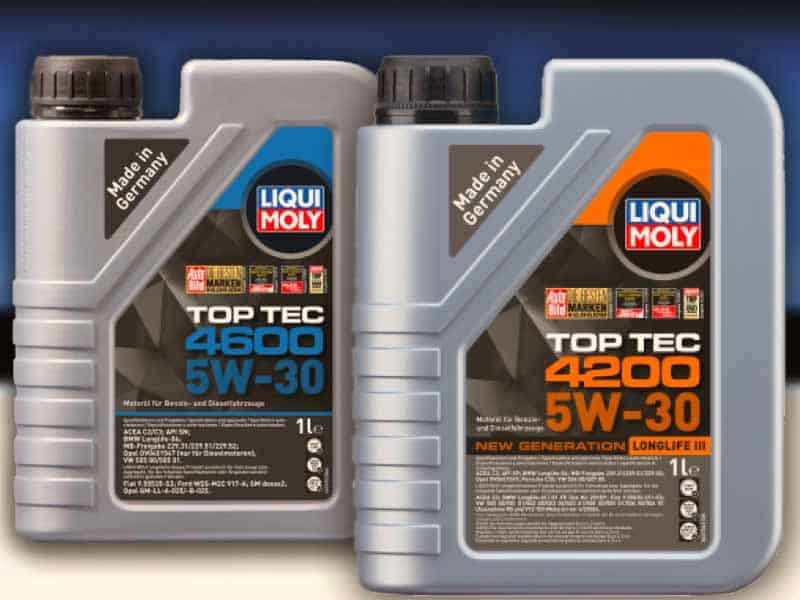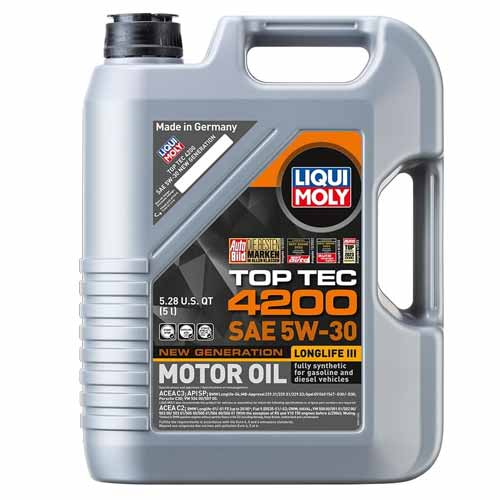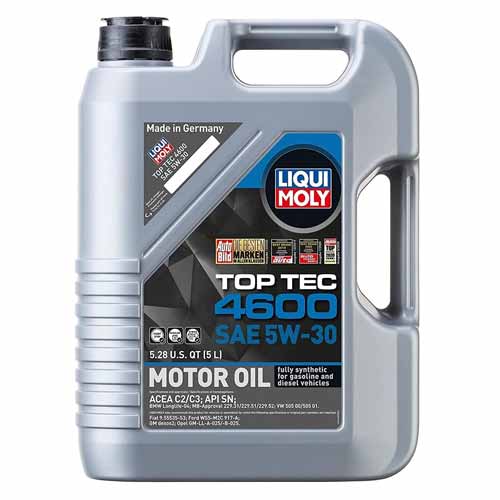Both contenders are 100% synthetic engine oils designed for gasoline and diesel engines integrated with a syntheses technology, delivering good efficiency and reducing friction.
Both contenders perform well in extreme weather conditions. And both of them meet the ACEA C3 standard which indicates low levels of SAPS (Sulphated Ash, Phosphorous, and Sulphur) in them.

Manufactured through Synthese Technology, Liqui Moly Top Tec 4200 offers ultimate protection in cold weather circumstances.
It would perform better in cold weather since its pour point value is relatively lower.
Besides being relatively more compatible with the catalytic converter, it also offers longer oil drainage intervals. It meets the API SP standard. Moreover, it’s compatible with a catalytic converter.
Like its competitor, the Liqui Moly Top Tec 4600 is also a high-tech motor oil designed through Synthese Technology to deliver enhance wear protection and engine cleaning abilities.
Despite being better in terms of sludge removal, fuel efficiency, and wear protection, it is less pricy than its competitor. It meets the API SN standard.
Compared to 4200, 4600 has enhanced wear protection, better cleaning ability, and improved fuel efficiency. On the other hand, 4200 has better low-temperature endurance, superior API rating, more compatibility with the catalytic converter, enhanced anti-foaming facility, and longer oil drainage interval.
Table of Contents
Side By Side Comparison


| Specifications | Top Tec 4200 (5W-30) | Top Tec 4600 (5W-30) |
| Oil Type | Fully Synthetic | Fully Synthetic |
| Engine Type | Gasoline, Natural Gas, and Diesel Engines | Gasoline, Natural Gas, and Diesel Engines |
| Formulated Technology | Synthese technology | Synthese technology |
| API Standards | SP | SN |
| ACEA | C2, C3 | C2, C3 |
| Available Viscosity Grades | SAE 5W-30 | SAE 5W-30 |
Viscosity Comparison
A lubricant’s kinematic viscosity determines the flow of liquid inside the engine.
The thickness and the fluid characteristics are determined by the kinematic viscosity.
Both contenders are tested for kinematic viscosity at lower and higher temperatures.
The result clearly shows that the kinematic viscosity of 4200 is relatively higher by a small margin at both temperatures than its competitor.
Hence 4600 will flow a little bit easier and will consume less fuel than its competitor to circulate.
It has been observed from the result that the kinematic viscosity and oil temperature are inversely proportional to each other which means that as the temperature increases, the kinematic viscosity decreases.
This change can be measured by an important parameter, which is a unit-less number, known as the viscosity index.
The less value of the index would indicate more change in the kinematic viscosity due to temperature alteration.
The viscosity index of both competitors is almost equivalent which suggests that the change in their viscosities due to environmental alteration would almost be the same.
| Parameter | Top Tec 4200 (5W-30) | Top Tec 4600 (5W-30) |
| Kinematic Viscosity @ +40°C | 70 mm²/s | 68.9 mm²/s |
| Kinematic Viscosity @ +100°C | 12.2 mm²/s | 12 mm²/s |
| Viscosity index | 173 | 172 |
Lubrication Standards
4600 and 4200 meet the API SN and API SP standards respectively. API SP is the latest standard and is superior to API SN in terms of efficiency, fuel economy, and performance.
Therefore, in this regard, 4200 takes the lead since its API SP rating is superior to its contender and is also backward compatible with API SN as well.
Endurance in Extreme Temperatures
The endurance of any lubricant at utmost temperature levels can be measured by two parameters; pour point and flashpoint. In high-temperature conditions, the flashpoint is the parameter that determines the endurance capability of a lubricant.
Both would be a better choice in high-temperature conditions since their flashpoint values are equivalent.
On the other hand, 4200 would perform better in cold weather since its pour point value is relatively lower.
It shows that it will not lose its flowing characteristics sooner than its competitor.
| Parameter | Top Tec 4200 (5W-30) | Top Tec 4600 (5W-30) |
| Pour point, °C | -42 | -39 |
| Flashpoint, °C | 230 | 230 |
Cleansing Ability
Oxidation breaks down engine oil molecules and mixes them with contaminants and dirt that can cause mud or accumulation in the engine.
Calcium, sodium, and magnesium are the major cleansing detergents that are being added to lubricants to solve the problem.
The total amount of these detergents in 4600 is relatively higher than its rival.
Foaming, the formation of small bubbles, in an engine oil also pollutes it.
This can be the result of pollution, cavitation, extreme irritation, or air intake.
To solve this problem, an anti-foaming agent, silicone, is being added to the engine oil. 4200 anti-foaming ability will be better as its silicone concentration is relatively high.
So the sludge removal ability of 4600 would be superior and 4200 takes the lead in providing an anti-foaming facility.
| Detergent | Top Tec 4200 (5W-30) | Top Tec 4600 (5W-30) |
| Calcium, ppm | 1504 | 2188 |
| Magnesium, ppm | 5 | 7 |
| Sodium, ppm | 1 | 0 |
| Silicone, ppm | 8 | 4 |
Anti-wear Protection
To enhance the wear protection of engine oils, anti-wear additives such as phosphorus, zinc, and boron are being added to them.
The sum of these additives’ concentrations will determine the anti-wear ability of engine oil.
As we can see in the table below, the total amount of anti-wear additives are relatively higher in 4600 than its opponent.
So 4600 would be a better choice for your wear protection
| Additive | Top Tec 4200 (5W-30) | Top Tec 4600 (5W-30) |
| Zinc, ppm | 862 | 1034 |
| Phosphorus, ppm | 796 | 933 |
| Boron, ppm | 3 | 7 |
Compatibility with Catalytic Converter
One of the key ingredients in anti-wear additives is zinc. Its major drawback is that it produces harmful zinc ash upon combustion which accumulates on the catalytic converter and affects its performance.
This is when a small amount of engine oil leaks into the combustion chamber and burns with the fuel. Therefore, the amount of zinc in engine oil will be proportional to the amount of harmful ash produced.
In the table above, we can see that the amount of zinc in the 4600 is relatively high.
Therefore, it will have a greater impact on the performance of the catalytic converter.
Therefore, 4200 will be relatively more compatible with Catalytic Converter than its opponent.
Oil Drainage
When Engine oil becomes acidic due to contamination, and sludge, it should be changed as the formation of acid can lead to engine breakdown.
Alkaline-based additives in lubricants control pH levels, but when they lose their ability to neutralize, engine oil becomes acidic and can cause engine malfunction.
The ability of lubricants to neutralize depends on the value of their TBN (Total Base Number).
Because the 4200’s TBN value is higher than its competitor, it will last longer in the engine and therefore the oil extraction interval will be longer.
| Parameter | Top Tec 4200 (5W-30) | Top Tec 4600 (5W-30) |
| Total base number, mg KOH/g | 8.5 mg KOH/g | 7.4 mg KOH/g |
Summary
Both competitors;
- are fully synthetic, high-tech, and low-friction engine oils designed for gasoline, natural gas, and diesel engines.
- would perform exceptionally well in high-temperature circumstances.
- would adapt to the change in environment the same way.
Top Tec 4200;
- is more compatible with catalytic converters than its competitor.
- meet the API SP standard, a superior standard.
- would perform relatively better in a cold environment.
- has a comparatively longer oil drainage interval.
- offers a better anti-foaming facility.
Top Tec 4600;
- provides better wear protection to engines.
- has a superior sludge and deposit removing ability and offers better cleaning to engines.
- is a more economical choice if you are looking for better anti-wear and cleaning ability.